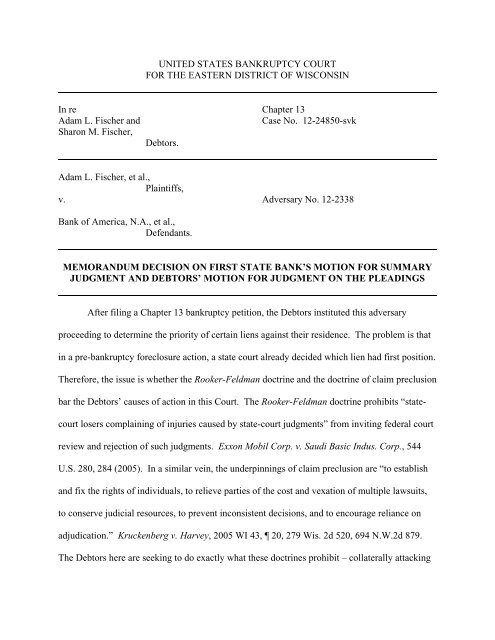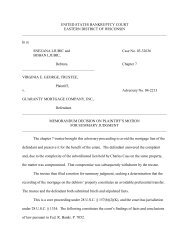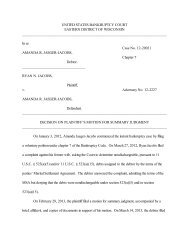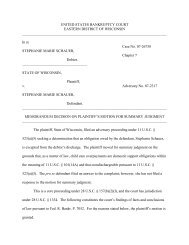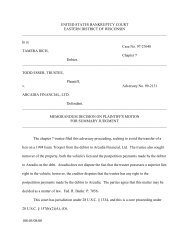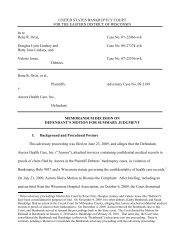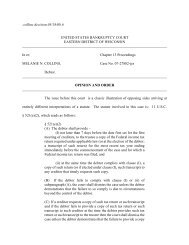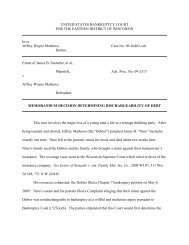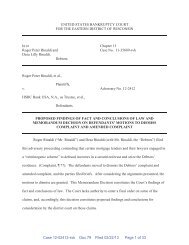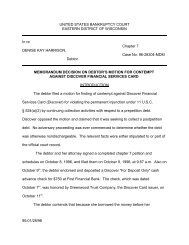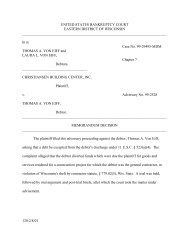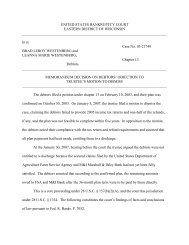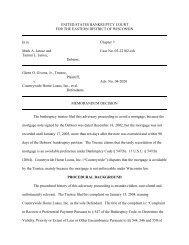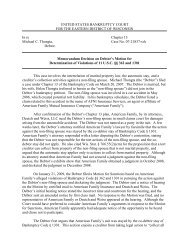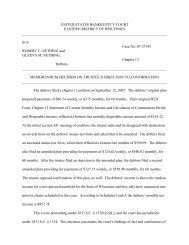Fischer v. Bank of America, N.A. - Eastern District of Wisconsin
Fischer v. Bank of America, N.A. - Eastern District of Wisconsin
Fischer v. Bank of America, N.A. - Eastern District of Wisconsin
You also want an ePaper? Increase the reach of your titles
YUMPU automatically turns print PDFs into web optimized ePapers that Google loves.
UNITED STATES BANKRUPTCY COURTFOR THE EASTERN DISTRICT OF WISCONSINIn re Chapter 13Adam L. <strong>Fischer</strong> andCase No. 12-24850-svkSharon M. <strong>Fischer</strong>,Debtors.Adam L. <strong>Fischer</strong>, et al.,Plaintiffs,v. Adversary No. 12-2338<strong>Bank</strong> <strong>of</strong> <strong>America</strong>, N.A., et al.,Defendants.MEMORANDUM DECISION ON FIRST STATE BANK’S MOTION FOR SUMMARYJUDGMENT AND DEBTORS’ MOTION FOR JUDGMENT ON THE PLEADINGSAfter filing a Chapter 13 bankruptcy petition, the Debtors instituted this adversaryproceeding to determine the priority <strong>of</strong> certain liens against their residence. The problem is thatin a pre-bankruptcy foreclosure action, a state court already decided which lien had first position.Therefore, the issue is whether the Rooker-Feldman doctrine and the doctrine <strong>of</strong> claim preclusionbar the Debtors’ causes <strong>of</strong> action in this Court. The Rooker-Feldman doctrine prohibits “statecourtlosers complaining <strong>of</strong> injuries caused by state-court judgments” from inviting federal courtreview and rejection <strong>of</strong> such judgments. Exxon Mobil Corp. v. Saudi Basic Indus. Corp., 544U.S. 280, 284 (2005). In a similar vein, the underpinnings <strong>of</strong> claim preclusion are “to establishand fix the rights <strong>of</strong> individuals, to relieve parties <strong>of</strong> the cost and vexation <strong>of</strong> multiple lawsuits,to conserve judicial resources, to prevent inconsistent decisions, and to encourage reliance onadjudication.” Kruckenberg v. Harvey, 2005 WI 43, 20, 279 Wis. 2d 520, 694 N.W.2d 879.The Debtors here are seeking to do exactly what these doctrines prohibit – collaterally attacking
a state court foreclosure judgment. This Court lacks subject matter jurisdiction to consider theDebtors’ claims, and even if it had jurisdiction, the doctrine <strong>of</strong> claim preclusion barsconsideration <strong>of</strong> the claims.Factual BackgroundOn May 16, 2012, the Debtors filed their Complaint against <strong>Bank</strong> <strong>of</strong> <strong>America</strong>, N.A.(“<strong>Bank</strong> <strong>of</strong> <strong>America</strong>”), Mortgage Electronic Registration Systems, Inc. (“MERS”), First State<strong>Bank</strong> (“First State”), and North Shore <strong>Bank</strong>, F.S.B. (“North Shore”). The Complaint concernsproperty located at N5386 Plier Road, Cecil, <strong>Wisconsin</strong> 54111 (the “Property”). The Debtorshave granted numerous mortgages against the Property in various refinancing transactions.According to the Complaint, Adam <strong>Fischer</strong> (the “Debtor”) purchased the Property onMarch 30, 2001 and granted mortgages to MERS as nominee for <strong>Bank</strong> <strong>of</strong> <strong>America</strong> and to <strong>Bank</strong>One. On August 28, 2002, the Debtor deeded the Property to himself and to his wife, co-DebtorSharon <strong>Fischer</strong> (collectively, the “Debtors”). At that time, the Debtors refinanced the mortgagesand granted one mortgage to Washington Mutual <strong>Bank</strong>, F.A. (“WaMu”) (the “2002 mortgage”).<strong>Bank</strong> One and MERS filed satisfactions <strong>of</strong> their mortgages with the Register <strong>of</strong> Deeds.On July 2, 2003, the Debtors again refinanced their mortgage and granted a mortgage toWaMu in the amount <strong>of</strong> $100,050 (the “2003 mortgage”). WaMu filed a satisfaction <strong>of</strong> its 2002mortgage with the Register <strong>of</strong> Deeds.On April 29, 2005, in order to secure a business loan, the Debtors granted a mortgage toFirst State in the amount <strong>of</strong> $226,989.59. This mortgage was in second position behind the 2003mortgage.On May 25, 2005, instead <strong>of</strong> assigning the 2003 mortgage, the Debtors refinanced the2003 mortgage and granted a new mortgage to <strong>Bank</strong> <strong>of</strong> <strong>America</strong>. As part <strong>of</strong> this transaction,2
<strong>Bank</strong> <strong>of</strong> <strong>America</strong> paid <strong>of</strong>f the balance due on the 2003 WaMu mortgage. WaMu filed asatisfaction <strong>of</strong> the 2003 mortgage with the Register <strong>of</strong> Deeds on July 5, 2005. On August 24,2005, <strong>Bank</strong> <strong>of</strong> <strong>America</strong> assigned its mortgage to MERS. On August 14, 2007, the Debtorsgranted a mortgage to North Shore in the amount <strong>of</strong> $10,000.On October 13, 2010, First State filed a foreclosure complaint in Shawano County CircuitCourt (Case No. 10-cv-480) against the Debtors, MERS, North Shore, and Riverside Finance,Inc. First State’s Shawano County Complaint avers in pertinent part:4. The defendant, [MERS] . . . is joined by virtue <strong>of</strong> being the assignee <strong>of</strong> amortgage by the [Debtors] to <strong>Bank</strong> <strong>of</strong> <strong>America</strong> in the amount <strong>of</strong> $116,000.00dated May 25, 2005 and recorded June 3, 2005 as Document No. 607917, theassignment there<strong>of</strong> being dated August 24, 2005 and recorded September 9, 2005as Document No. 611872.. . .13. [The Debtors] hold fee simple title to the subject property in ShawanoCounty, <strong>Wisconsin</strong> and executed a Mortgage dated April 29, 2005 and recordedon May 18, 2005 at 11:11 a.m. as Document No. 607342, granting [First State] asecurity interest in [the Property.]14. Said Mortgage secures the original stated principal note amount <strong>of</strong>$226,989.56 together with all other additional sums loaned by or owed to [FirstState].. . .18. [First State] is entitled to senior and superior priority in and to [the Property.]19. The defendants, [MERS, North Shore and Riverside Finance] have, claim tohave, or may have an interest in the mortgaged Shawano County property, byvirtue <strong>of</strong> said defendants’ respective recorded mortgages from or docketedjudgments filed as judgment liens or encumbrances against [the Debtors], but saidinterests are junior, subordinate, and subsequent in priority to the senior andsuperior interest <strong>of</strong> plaintiff, [First State], therein.On November 12, 2010, after MERS failed to answer or otherwise respond, the ShawanoCounty Circuit Court entered Default Judgment against it. The Default Judgment declared anddetermined that First State held the first priority lien on the Debtors’ Property: “IT IS HEREBYADJUDGED: That the plaintiff, [First State], has and holds senior and superior priority in the3
[Property] which is the subject matter <strong>of</strong> the above-captioned action and that any interests <strong>of</strong> thedefendant, [MERS], therein are junior, subordinate, and subsequent to the senior and superiorpriority <strong>of</strong> [First State].” (Kuehl Decl., Exh. A). On March 28, 2011, MERS moved to vacatethe Default Judgment, but the court denied the motion by Order entered April 12, 2011. (KuehlDecl., Exh. C). <strong>Bank</strong> <strong>of</strong> <strong>America</strong> 1 also moved to intervene in the action, but the court denied thatmotion as well.On September 26, 2011, the Shawano County Circuit Court issued Findings <strong>of</strong> Fact,Conclusions <strong>of</strong> Law, and Judgment <strong>of</strong> Foreclosure and granted First State summary judgmentagainst the Debtors and the other defendants. In this judgment the Court granted First State anon-deficiency foreclosure judgment with respect to the Property. (Kuehl Decl., Exh. B). TheFindings <strong>of</strong> Fact provide that no “objection or opposition” was filed to First State’s motion forsummary judgment. (Id.) First State was the high bidder at the sheriff’s sale on the Property onApril 11, 2012. (Kuehl Decl., Exh. D). The Debtors filed their Chapter 13 petition on April 12,2012, prior to confirmation <strong>of</strong> the sheriff’s sale. 2Since <strong>Bank</strong> <strong>of</strong> <strong>America</strong> paid <strong>of</strong>f the 2003 mortgage which was in first position, theDebtors contend, under the theory <strong>of</strong> equitable subrogation, that <strong>Bank</strong> <strong>of</strong> <strong>America</strong>’s mortgageshould be given priority above First State’s mortgage. Subrogation is an equitable doctrineintended to avoid unjust enrichment. The <strong>Wisconsin</strong> Supreme Court explained: “Under what isgenerally termed ‘conventional subrogation,’ a lender will be granted subrogation where money1 This Motion was brought in the name <strong>of</strong> BAC Home Loans Servicing, LP, which will be referred to herein as <strong>Bank</strong><strong>of</strong> <strong>America</strong>.2 The Debtors received a discharge in a Chapter 7 case on March 29, 2010. They are ineligible for discharge in thisChapter 13 proceeding. 11 U.S.C. § 1328(f)(1). This Court has held that a debtor who does not qualify for adischarge in a Chapter 13 case cannot “strip <strong>of</strong>f” a junior lien. Blosser v. KLC Fin., Inc. (In re Blosser), 2009 <strong>Bank</strong>r.LEXIS 1049 (<strong>Bank</strong>r. E.D. Wis. Apr. 15, 2009). Even if jurisdictional matters were not at issue here, the Debtorsmay not be allowed to avoid the second mortgage because they are ineligible for discharge.4
is advanced in reliance upon a justifiable expectation that the lender will have security equivalentto that which his advances have discharged, provided that no innocent third parties will suffer.”Rock River Lumber Corp. v. Universal Mortg. Corp., 82 Wis. 2d 235, 241, 262 N.W.2d 114, 117(1978) (internal citation omitted). Assuming they prevail on their request to equitably subrogate<strong>Bank</strong> <strong>of</strong> <strong>America</strong>’s position to the priority <strong>of</strong> WaMu’s 2003 mortgage, the Debtors ask to strip<strong>of</strong>f First State’s and North Shore’s junior mortgages because there is no equity for thesemortgages after property taxes and the <strong>Bank</strong> <strong>of</strong> <strong>America</strong> mortgage. 3On September 13, 2012, the Debtors filed a Motion for Judgment on the Pleadings. OnSeptember 14, 2012, First State filed a Motion for Summary Judgment. 4In its Motion, FirstState alleged that the Rooker-Feldman doctrine and res judicata (a/k/a claim preclusion) bar theDebtors’ claims against First State. 5AnalysisA party may move for judgment on the pleadings after the complaint and answer havebeen filed. Fed. R. <strong>Bank</strong>r. P. 7012(b). A court reviews a motion for judgment on the pleadings“by employing the same standard that applies when reviewing a motion to dismiss for failure tostate a claim under Rule 12(b)(6).” Buchanan-Moore v. County <strong>of</strong> Milwaukee, 570 F.3d 824,827 (7th Cir. 2009) (citing Pisciotta v. Old Nat. Bancorp, 499 F.3d 629, 633 (7th Cir. 2007)).The Court will “view the facts in the complaint in the light most favorable to the nonmoving3 According to the Debtors’ Complaint, as <strong>of</strong> April 12, 2012, the principal balance <strong>of</strong> the <strong>Bank</strong> <strong>of</strong> <strong>America</strong> mortgagewas $106,931.33, and an April 14, 2012 appraisal estimates the fair market value <strong>of</strong> the Property at $95,000. If<strong>Bank</strong> <strong>of</strong> <strong>America</strong> is in first place, there would be no equity to which First State’s mortgage lien could attach.4 On November 6, 2012, this Court granted the Debtors’ Motion for Default Judgment against North Shore; it cannotseriously be disputed that the North Shore mortgage is in third position and there is no equity in the Property towhich this mortgage can attach.5 In its Answer, First State also stated as an affirmative defense that the doctrine <strong>of</strong> issue preclusion bars theDebtors’ claims. The Debtors rebutted this argument in their Memorandum in Support <strong>of</strong> their Motion for Judgmenton the Pleadings. First State did not further address this doctrine on summary judgment or elsewhere, so the Courtwill not consider it here.5
party and will grant the motion ‘only if it appears beyond doubt that the plaintiff cannot proveany facts that would support his claim for relief.’” Id. (quoting Northern Indiana Gun andOutdoor Shows, Inc. v. City <strong>of</strong> South Bend, 163 F.3d 449, 452 (7th Cir. 1998)).With respect to First State’s Motion, summary judgment is appropriate only when theevidence presented shows that no genuine issue <strong>of</strong> material fact exists, and the moving party isentitled to judgment as a matter <strong>of</strong> law. Fed. R. <strong>Bank</strong>r. P. 7056; Eisencorp, Inc. v. RockyMountain Radar, Inc., 398 F.3d 962, 965 (7th Cir. 2005). All inferences are drawn in the lightmost favorable to the non-moving party. Id.The Rooker-Feldman DoctrineFirst State argues that the Rooker-Feldman doctrine prevents this Court from altering theShawano County Circuit Court’s judgment on the priority <strong>of</strong> liens. The Rooker-Feldmandoctrine is jurisdictional in nature; its applicability must be determined before any otheraffirmative defense, including claim preclusion. Long v. Shorebank Dev. Corp., 182 F.3d 548,554-55 (7th Cir. 1999) (citing Garry v. Geils, 82 F.3d 1362, 1365 (7th Cir. 1996)). Under thisdoctrine, “lower federal courts do not have subject matter jurisdiction over claims seeking review<strong>of</strong> state court judgments.” Id. at 554. The doctrine applies both to claims actually raised beforethe state court and to claims that are “inextricably intertwined with state court determinations.”Id.In assessing the applicability <strong>of</strong> the Rooker-Feldman doctrine, the fundamental questionis “‘whether the injury alleged by the federal plaintiff resulted from the state court judgmentitself or is distinct from that judgment.’” Lewis v. Anderson, 308 F.3d 768, 772 (7th Cir. 2002)(citing Rizzo v. Sheahan, 266 F.3d 705, 713 (7th Cir. 2001)). “[I]f the alleged injury is distinctfrom the state court judgment and not inextricably intertwined with it, the Rooker-Feldman6
doctrine does not apply, although the doctrines <strong>of</strong> claim and issue preclusion may be applicable.”Long, 182 F.3d at 555 (quotations and citations omitted). As the court stated in Zurich Am. Ins.Co. v. Superior Court for Cal., 326 F.3d 816, 821 (7th Cir. 2003) (quoting GASH Assocs. v. Vill.<strong>of</strong> Rosemont, 995 F.2d 726, 728 (7th Cir. 1993)):The Rooker-Feldman doctrine asks: is the federal plaintiff seeking to set aside astate judgment, or does he present some independent claim, albeit one that deniesa legal conclusion that a state court has reached in a case to which he was a party?If the former, then the district court lacks jurisdiction; if the latter, then there isjurisdiction and state law determines whether the defendant prevails underprinciples <strong>of</strong> preclusion.If claims directly seek to set aside a state court judgment, they “are de facto appeals andare barred without additional inquiry.” Taylor v. Fannie Mae, 374 F.3d 529, 532 (7th Cir. 2004).The Rooker-Feldman doctrine analysis is not altered by the fact that the federal claim is “cloakedin the guise <strong>of</strong> an adversary proceeding in bankruptcy court. . . .” Knapper v. <strong>Bank</strong>ers Trust Co.(In re Knapper), 407 F.3d 573, 581 (3d Cir. 2005) (citing Baldino v. Wilson (In re Wilson), 116F.3d 87 (3d Cir. 1997)).The Rooker-Feldman doctrine has been applied to bar collateral attacks on state courtforeclosure judgments. Kline v. Deutsche <strong>Bank</strong> Nat’l Trust Co. (In re Kline), 472 B.R. 98, 105(B.A.P. 10th Cir. 2012). Notably, this includes default judgments. See, e.g., Stewart v.JPMorgan Chase <strong>Bank</strong>, N.A. (In re Stewart), 473 B.R. 612, 630 (<strong>Bank</strong>r. W.D. Pa. 2012) (“Thejurisdictional limitations imposed by Rooker-Feldman apply not only to state court judgmentsentered following a trial on the merits, but also to default judgments.”); Randall v. <strong>Bank</strong> OneNat’l Ass’n (In re Randall), 358 B.R. 145, 159 (<strong>Bank</strong>r. E.D. Pa. 2006) (“[T]he Third Circuit hasheld . . . that a default judgment in mortgage foreclosure, prior to any sale, was sufficient totrigger application <strong>of</strong> Rooker-Feldman.”).7
Here, after MERS (the alleged first lien holder, according to the Debtors) failed to answeror otherwise respond in the Shawano County case, the court entered Default Judgment against it.The Default Judgment adjudged that First State holds the “senior and superior priority in theProperty” and that any interest <strong>of</strong> MERS is subordinate. Upon receiving no objection to FirstState’s Motion for Summary Judgment, the Shawano County Court granted the Motion againstthe remaining defendants. The Debtors did not assert a counterclaim or cross-claim in theShawano County case despite the opportunity to do so. The Shawano County Circuit Courtrejected attempts by MERS and <strong>Bank</strong> <strong>of</strong> <strong>America</strong> to remedy their failure to participate in theaction by denial <strong>of</strong> MERS’s motion to vacate the Default Judgment and <strong>Bank</strong> <strong>of</strong> <strong>America</strong>’smotion to intervene. The Debtors and <strong>Bank</strong> <strong>of</strong> <strong>America</strong> disagree with the state court’s decisions,but this Court is not the forum to raise that disagreement. The Debtors and <strong>Bank</strong> <strong>of</strong> <strong>America</strong>could have and should have sought relief from the Shawano County Circuit Court, and if thatrelief was not forthcoming, they could have appealed. The Debtors now seek to have <strong>Bank</strong> <strong>of</strong><strong>America</strong>’s position declared superior to First State, when First State’s position already wasadjudicated as superior in state court. The Rooker-Feldman doctrine prevents this.The Debtors cite Bozich v. Mattschull (In re Chinin USA, Inc.), 327 B.R. 325, 336(<strong>Bank</strong>r. N.D. Ill. 2005) for the proposition that the Rooker-Feldman doctrine does not apply tothe bankruptcy court’s avoidance, modification or discharge <strong>of</strong> state court judgments. TheDebtors miss the point. The <strong>Bank</strong>ruptcy Code enables the trustee to avoid a state court judgmentas a preferential transfer, and permits a debtor to avoid a state court judgment lien to the extent itimpairs the debtor’s exemptions. See 11 U.S.C. §§ 547, 522. And the power to discharge debtsis a well-known exception to the Rooker-Feldman doctrine. See, e.g., In re Moreno, 479 B.R.553, 572 (<strong>Bank</strong>r. E.D. Cal. 2012) (the doctrine is not applicable when the bankruptcy court is8
presented with matters relating to the enforcement <strong>of</strong> the discharge injunction). Thesebankruptcy court powers radically differ from what the Debtors seek here: reordering mortgageliens from the priority already established by a state court foreclosure judgment. The Debtorsargue that they have presented issues unique from those presented in the foreclosure case – lienpriority and avoidance <strong>of</strong> wholly unsecured junior mortgages. This argument also fails. Lienpriority was precisely the issue before the Shawano County Court, and the Debtors’ attempt toavoid unsecured junior mortgages after engineering a reversal <strong>of</strong> the state court’s prioritydetermination certainly is “inextricably intertwined” with the lien priority issue and cannot beseen as an “independent claim.”Applying the Rooker-Feldman doctrine, the Court finds it does not have jurisdiction overthis matter. Even assuming the Court found to the contrary, however, the Court finds that thedoctrine <strong>of</strong> claim preclusion bars all claims made in this proceeding.Claim PreclusionThe doctrine <strong>of</strong> claim preclusion provides that a “final judgment on the merits <strong>of</strong> anaction precludes the parties or their privies from relitigating issues that were or could have beenraised in that action.” Federated Dep’t Stores v. Moitie, 452 U.S. 394, 398 (1981). When thedoctrine is applied, it will bar all matters that either were litigated or that might have beenlitigated in a former proceeding. Kruckenberg v. Harvey, 2005 WI 43, 19, 279 Wis. 2d 520,694 N.W.2d 879. In <strong>Wisconsin</strong>, claim preclusion has three elements: “(1) identity between theparties or their privies in the prior and present suits; (2) prior litigation resulted in a finaljudgment on the merits by a court with jurisdiction; and (3) identity <strong>of</strong> the causes <strong>of</strong> action in thetwo suits.” Id. at 21 (quotations and citations omitted). The party asserting the applicability <strong>of</strong>claim preclusion bears the burden <strong>of</strong> pro<strong>of</strong>. Pasko v. City <strong>of</strong> Milwaukee, 2002 WI 33, 16, 2529
Wis. 2d 1, 643 N.W.2d 72 (citing Alexopoulos v. Dakouras, 48 Wis. 2d 32, 37, 179 N.W.2d 836(1970)). An exception to the doctrine <strong>of</strong> claim preclusion is “if the plaintiff did not have a fulland fair opportunity to litigate his claim in state court. . . . A plaintiff is afforded a full and fairopportunity to litigate his claims so long as the state court proceedings complied with theminimum procedural requirements <strong>of</strong> the Due Process Clause.” Licari v. City <strong>of</strong> Chi., 298 F.3d664, 666-67 (7th Cir. 2002). The fact that the state case ended in a default judgment does notchange the analysis; indeed, “[c]ourts have consistently applied res judicata to defaultjudgments.” In re Walz, 44 B.R. 973, 975 (<strong>Bank</strong>r. W.D. Wis. 1984).In determining the preclusive effect <strong>of</strong> a state court judgment, this Court is to apply thelaw <strong>of</strong> the state in which the judgment was rendered. Migra v. Warren City School Dist. Bd. <strong>of</strong>Education, 465 U.S. 75, 81 (1984). For purposes <strong>of</strong> analyzing claim preclusion in the context <strong>of</strong>a default judgment in <strong>Wisconsin</strong>, “[t]he conclusiveness <strong>of</strong> a default judgment . . . is limited to thematerial issuable facts which are well pleaded in the declaration or complaint. The judgmentdoes not extend to issues which were not raised in the pleadings.” Menard, Inc. v. LitewayLighting Prods., 2005 WI 98, 34, 282 Wis. 2d 582, 698 N.W.2d 738 (citations and quotationsomitted); see also Klaus v. Vander Heyden, 106 Wis. 2d 353, 359, 316 N.W.2d 664 (1982)(“Although the general rule is that a court may grant such relief as it feels a party is entitled to,even if such relief has not been demanded, this rule sees exception with default judgments. Inthe case <strong>of</strong> a default judgment, relief is limited to that which is demanded in the plaintiff’scomplaint.”); A.B.C.G. Enterprises v. First <strong>Bank</strong> Southeast, N.A., 184 Wis. 2d 465, 481, 515N.W.2d 904 (1994) (citing Mitchell v. Jones, 172 Cal. App. 2d 580, 342 P.2d 503, 506-07(1959), for this proposition: “default judgment is res judicata as to all issues aptly pleaded in the10
complaint, and defendant is estopped to deny in a future action any allegation contained in theformer complaint”).<strong>Wisconsin</strong> adheres to the standard <strong>of</strong> “notice pleading” in a complaint. Liebovich v.Minn. Ins. Co., 2008 WI 75, 40, 310 Wis. 2d 751, 751 N.W.2d 764. According to the<strong>Wisconsin</strong> Statutes, a complaint must contain “[a] short and plain statement <strong>of</strong> the claim,identifying the transaction or occurrence or series <strong>of</strong> transactions or occurrences out <strong>of</strong> which theclaim arises and showing that the pleader is entitled to relief.” Wis. Stat. § 802.02(1)(a). Thisstatute similarly directs that “[e]ach averment <strong>of</strong> a pleading shall be simple, concise, and direct.”Wis. Stat. § 802.02(5)(a). Under these notice pleadings requirements, “a complaint must simplycontain [a] short and plain statement <strong>of</strong> the claim, identifying the transaction or occurrence orseries <strong>of</strong> transactions or occurrences out <strong>of</strong> which the claim arises and showing that the pleader isentitled to relief. These claims are to be liberally construed [so] as to do substantial justice.”Doe 67C v. Archdiocese <strong>of</strong> Milwaukee, 2005 WI 123, 35, 284 Wis. 2d 307, 700 N.W.2d 180(quotations and citations omitted).Applying the elements <strong>of</strong> claim preclusion under <strong>Wisconsin</strong> law, there is an identity <strong>of</strong>the parties (the Debtors, First State, MERS, and North Shore <strong>Bank</strong>, and <strong>Bank</strong> <strong>of</strong> <strong>America</strong> soughtto intervene) and an identity <strong>of</strong> the causes <strong>of</strong> action (priority <strong>of</strong> lien) between this adversaryproceeding and the Shawano County case. The Debtors argue that the second element – that theprior litigation resulted in a “final judgment” – is not met here because the sheriff’s sale was notconfirmed. However, the judgment <strong>of</strong> foreclosure and sale determines the parties’ legal rights inthe mortgaged property. Shuput v. Lauer, 109 Wis. 2d 164, 325 N.W.2d 321 (1982). Anychallenge to the priority <strong>of</strong> the First State mortgage should have been made in connection withthe judgment <strong>of</strong> foreclosure. Id. Although recognizing that claim preclusion may attach in cases11
involving default judgments, the Debtors rely on Menard to argue that the conclusiveness <strong>of</strong> adefault judgment is limited to facts that are well pleaded in the complaint. The Debtors arguethat the Shawano County complaint did not sufficiently plead that “anything was out <strong>of</strong> theordinary with respect to the material issue <strong>of</strong> lien priority.”Quite to the contrary. First State’s Shawano County complaint specifically stated that“[First State] is entitled to senior and superior priority in and to [the Property.]” It also notedthat “[t]he defendants, [MERS, North Shore, and Riverside Finance] have, claim to have, or mayhave an interest in the [Property] by virtue <strong>of</strong> said defendants’ respective recorded mortgagesfrom or docketed judgments filed as judgment liens or encumbrances against [the Debtors], butsaid interests are junior, subordinate, and subsequent in priority to the senior and superior interest<strong>of</strong> plaintiff, [First State], therein.” This “short and plain statement <strong>of</strong> the claim” is sufficientunder <strong>Wisconsin</strong>’s notice pleading standard to put all parties on notice that lien priority may beat issue. After service <strong>of</strong> the complaint, each defendant had the opportunity to investigate thispriority issue further and participate in the case, but each defendant either defaulted or failed torespond to summary judgment. Claim preclusion applies to either matters that were litigated “orthat might have been litigated in a former proceeding.” Kruckenberg, supra. The parties,including the Debtors, had the full and fair opportunity to litigate whether First State or <strong>Bank</strong> <strong>of</strong><strong>America</strong> or its assignee, MERS, was in first position. The Court finds that all aspects <strong>of</strong> the statecourt proceeding complied with minimum due process requirements. Even if the Court foundthat it had subject matter jurisdiction over this matter, the doctrine <strong>of</strong> claim preclusion bars theclaims related to lien priority.12
ConclusionFor the foregoing reasons, the Court grants First State’s Motion for Summary Judgmentand finds that it is entitled to judgment as a matter <strong>of</strong> law; the Court lacks subject matterjurisdiction under the Rooker-Feldman analysis, and even if it had jurisdiction, the doctrine <strong>of</strong>claim preclusion bars the Debtors’ claims to reorder lien priority. The Court denies the Debtors’Motion for Judgment on the Pleadings and finds that the Debtors have not established that FirstState cannot prove any facts supporting its claims for relief. A separate Order consistent withthis Memorandum Decision will be entered.Dated: December 27, 201213


